When I first visited China in the late nineteen nineties, I don't think any of the marvels I saw amazed me as much as Roscoea: the high valley at the east base of the Jade Dragon mountains had untold millions of them in bloom in late May: pale yellow, almost white, pink, lavender, purple--you name the color it was there, it seemed. Most were very tiny in stature, although the flowers were sizeable. They grew in the fields, among rhododendrons, they grew in the woods. They were enchanting! How Ms. Cowley was able to disentangle them and turn them into that wonderful Timber press monograph is beyond me...
We've grown quite a few over the years in Denver, mostly the squinny flowered miniatures like R. tibetica or R. alpina, thinking they were the most apt to be hardy. Then one day we managed to grow Roscoea cautleioides from seed: it lasted quite a few years and made a great statement in the Rock Alpine Garden. These two individuals are growing in Plantasia, and they are making a fabulous spectacle in June. They even set quite a bit of seed this year.
Good rich soil that suits primulas is best, and regular irrigation through the summer months. I think they can go quite dry in the winter. Worth every effort to grow these!
Comments
Re: Roscoea
I stand corrected! By the way...I would be HAPPY to relieve you of some of those excess, annoying things cluttering up your garden! I daresay I could arrange an exchange of hostages...
Re: Roscoea
I stand corrected! By the way...I would be HAPPY to relieve you of some of those excess, annoying things cluttering up your garden! I daresay I could arrange an exchange of hostages...
We can work towards an exchange :D I think my challenge is to find a way to grow them with companion plants, to better support/conceal the ragged flowering aftermath.
At least when the cornstalks of Juno Iris get done with their spring display, they have the decency to go dormant and shut down for the year.
The one I want to try is R. purpurea 'Red Gurkha', take a look:
http://www.plantsforshade.co.uk/acatalog/Roscoea.html
http://desirableplants.com/Roscoea%20purpurea%20'Red%20Gurkha'.jpg
If you really want a feast for the eyes, check out John Jearrard's pages on Roscoea (don't miss the bottom link, it'll knock your socks off). And R. wardii looks fabulous too.
http://www.johnjearrard.co.uk/plants/roscoea/roscoea.html
http://www.johnjearrard.co.uk/plants/roscoea/roscoeapurpurearedgurkha/ro...
Re: Roscoea
I've seen Red Gurkha at Wisley last year, and I believe I saw it at Kew before that: it is even nicer in real life. Don't know a US source, however...
Do you have Cowley's terrific monograph? Fascinating to see the range of these little gingers. It is especially strange that in the wild they seem to be extremely dwarf (from a distance they looked like crocuses, almost, or bits of tissue paper on the ground)--at least in the Yulongshan, but in cultivation they all get comparatively monstrous.
Re: Roscoea
I've seen Red Gurkha at Wisley last year, and I believe I saw it at Kew before that: it is even nicer in real life. Don't know a US source, however...
Do you have Cowley's terrific monograph? Fascinating to see the range of these little gingers. It is especially strange that in the wild they seem to be extremely dwarf (from a distance they looked like crocuses, almost, or bits of tissue paper on the ground)--at least in the Yulongshan, but in cultivation they all get comparatively monstrous.
No, I don't have the monograph. However, looking at John Jearrard's extensive studied list of Roscoea (see link above), where he is attempting to vet and correctly identify the many species and cultivars (where confusion reigns), is an invaluable resource for those interested in the genus. Seems too, that a large number of cultivars got named that aren't very different than the type species. One year, Russell Stafford at Odessey Bulbs had a number of these Roscoea forms, but apparently they weren't overly popular.
Re: Roscoea
I've tried this species and alpinum from seed and all ended up that miserable species R. scilloides....and it now self-seeding all over!
Re: Roscoea
I've tried this species and alpinum from seed and all ended up that miserable species R. scilloides....and it now self-seeding all over!
There isn't a R. scilloides, although that spelling can be found all over the web and plant forums, but there is a R. scillifolia. It is the one that has been confused with R. alpina. If you go through the John Jearrard link (above), enumerating a list of Roscoea species and cultivars, one can find some good looking species and cultvars, and some not so good overly-leafy things. The list contains some notes on common confusion or misidentified species. While I'm no expert on these plants, my guess is that they would prefer a milder, more moist climate such as yours, than in a drier climate.
Re: Roscoea
Can anyone show us just how miserable and squinny is R. scillifolia? My inarguable logic tells me that if any Roscoea is remotely capable of survival here, it could only possibly be this least-desirable one... Hey, I might settle for it! ;D
(NB. I did try Roscoea purpurea one year... poor doomed thing.)
Re: Roscoea
Can anyone show us just how miserable and squinny is R. scillifolia? My inarguable logic tells me that if any Roscoea is remotely capable of survival here, it could only possibly be this least-desirable one... Hey, I might settle for it!
(NB. I did try Roscoea purpurea one year... poor doomed thing.)
Russell Stafford of Odessey Bulbs mentioned to me that the numerous R. purpurea forms are not as hardy as some other species, and the only one he considers tried and true hardy is R. cautleyoides. Russell gardens about 20 miles from me in Massachusetts, USDA Zone 5. Since most of the history of cultivation of these things is based in the UK, we'll still need to learn about their adaptability (by trial and error) to colder climates of North America.
Re: Roscoea
Here is my scillifolia....the blooms are maybe an inch in size.
Yeah, that's kind of a small pale bloom isn't it? My problem with many Roscoea is the heavy leafage-to-flower ratio. There is a dark (black) flowered form of scillifolia, but perhaps even with that one, it has too much foliage compared to flower size. http://www.johnjearrard.co.uk/plants/roscoea/roscoeascillifoliablackform...
For other species, even the lovely-when-in-flower R. cautleyoides, they can become a lackadaisical leafy mass of fallen corn stalks. But maybe some species are better behaved in growth, I'm willing to give them a try, or at least find a better way of dealing with foliage after flowering. The seeds take so long to ripen, that I suppose it may harm the plant or harm seed production if one were to cut off foliage prematurely.
Re: Roscoea
Quite the avatar you have there, Mark! Made me dizzy...
I'm fascinated by all this talk of leggy, lanky Roscoea, when everything I saw in the field was dinky, almost stemless on the ground like crocuses...And they grew at a very lofty elevation. Obviously there's a disconnect.
It's true the handful of species I have grown in the garden are biggish (and come to think of it many have not persisted...) But Colchicums, many irises and daffodils all have messy foliage once they bloom. You have to site them carefully as a consequence.
I am enchanted with these hardy gingers: This discussion is inspiring me to grow more!
Re: Roscoea
I'm fascinated by all this talk of leggy, lanky Roscoea, when everything I saw in the field was dinky, almost stemless on the ground like crocuses...And they grew at a very lofty elevation. Obviously there's a disconnect.
But Colchicums, many irises and daffodils all have messy foliage once they bloom. You have to site them carefully as a consequence.
I only have experience growing R. cautleyoides, and based on that species I supply my honest assessment. For me, garden plants that keep their foliage all growing season long, up until the fall, must be judged on how they look the remaining 5 months after flowering. R. cautleyoides is an eyesore after flowering. At least with the bulbs mentioned, the foliage dies back and can be cleaned up a couple months after flowering. But even with those, I'm thinking of reticulate Iris that sprout absurdly long foliage after flowering (maybe they're actually in the "ridiculate" Iris group ;D ). Measured leaf lengths on some of my I. histrioides hybrids last year that exceeded 3' in length :o But as I did mention, I'm up to the challenge of finding planting scenarios or pairings that'll mitigate the issue of ugly flopping stems and foliage after flowering. The disconnect could be I have experience with only one species, maybe the other species are not as leafy and flopping after flowering... I have an open mind about it, and planted two more species this fall.
Re: Roscoea
Mark,
You have a point, and yet I enjoy a good Roscoea flowering -I'm willing to accept the flopping in exchange. It flowers at a time of year, midsummer, when it seems everything else is done, not started yet, or is taking a break. Growing a few sedges or grasses nearby would give you something to tuck this flopping foliage behind, but this is not a style of gardening everyone goes for. Personally I find this also works for bulb foliage once it's seen better days. Have you tried Roscoea capitata? I have had it several years in western Pennsylvania, It just might do okay where you are. I also have Roscoea x beesiana, which I find squinny as well -larger than tibetica but still not adequate in the flower to foliage proportion. It was sold to me many years ago as capitata but has been a disappointment. The flopping outweighs the flowering in this case.
One thing I've never done successfully is winter over any Roscoea seedlings. They germinate very willingly, but whether in a cold frame or in a refrigerator, they've always rotted away by spring. I'll try the scratching-in technique and see how that works.
Re: Roscoea
Mark,
You have a point, and yet I enjoy a good Roscoea flowering -I'm willing to accept the flopping in exchange. It flowers at a time of year, midsummer, when it seems everything else is done, not started yet, or is taking a break. Growing a few sedges or grasses nearby would give you something to tuck this flopping foliage behind, but this is not a style of gardening everyone goes for. Personally I find this also works for bulb foliage once it's seen better days. Have you tried Roscoea capitata? I have had it several years in western Pennsylvania, It just might do okay where you are. I also have Roscoea x beesiana, which I find squinny as well -larger than tibetica but still not adequate in the flower to foliage proportion. It was sold to me many years ago as capitata but has been a disappointment. The flopping outweighs the flowering in this case.
One thing I've never done successfully is winter over any Roscoea seedlings. They germinate very willingly, but whether in a cold frame or in a refrigerator, they've always rotted away by spring. I'll try the scratching-in technique and see how that works.
Hi Paul, well I did have a tremendous flowering on R. cautleyoides in 2009 to save it from being thrown out ;D Yes indeed, it emerges very late, then flowers late... it is welcome for its flowering, but not the *aftermath*. I think you are right to suggest interplanting with sedges, as that might do the trick of blending in the flopping foliage; I shall consider the siting possibilities.
I haven't tried other species, such as R. capitata, although at a local NARGS meeting this past fall, I bought R. auriculata and R. australis, to give them a try (both seemed to be small ones), and I sowed seed of R. yunnanensis (none germinated yet), so I maintain an open mind.
Regarding seedlings of R. cautleyoides, do try the "sow-in-situ" methodology, this is working beyond my wildest imagination for so many plant species, and its a salvation for the "working man or woman" who doesn't have time to attend to small pots of seedlings.
I upload yet another photo of bad flopping foliage in 2007, and beside it you can see lots of seedlings from "in situ" seed sowing, and a second photo showing those seedlings. I have sown seed in situ these last three years, and they always come up each year and are persistent, so I recomment that technique.
Re: Roscoea
Roscoea cautleyoides has just emerged, almost two weeks earlier than normal, and that is to say, it is a very late emerging plant. The seedlings that grow nearby, are always even later to emerge. In the second photo, a top view, the shoots look rather comical, like little pipes.
Re: Roscoea
I forgot to show what the floral show looked like this year; pretty good but not as good as in 2009. I include a second photo showing the glorious fall foliage one may expect in the coming months :P ;D
Re: Roscoea
And a photo of a younger plant taken in Peter George's garden. One has to admit, the plants are mighty photogenic in flower.

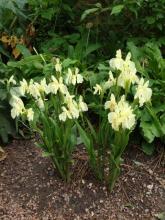
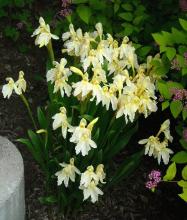
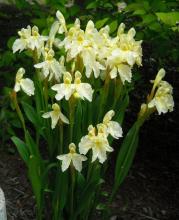
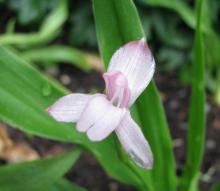
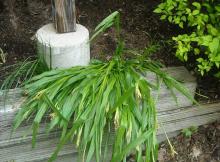
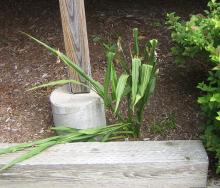
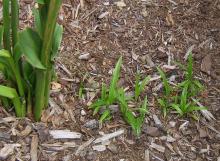
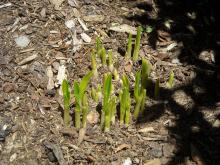
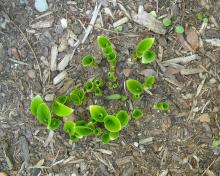
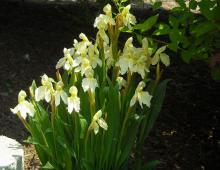
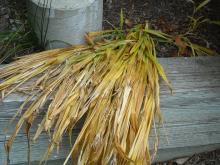
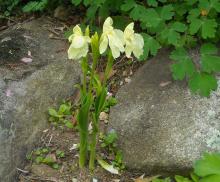
I have a love/hate relationship with this plant. Over the course of nine years growing it, I've been tempted more than a few times to toss it out. Yes, it makes a pleasant show of orchid-like blooms in late spring, but afterwards the stiff stems and leafage elongate to 24-30", the tatty flopping mass an eyesore persisting all season long. And then unfailingly each fall, amid the unsightly heap of foliage and collapsed stems, sprout forth a second flower display, the smaller blooms looking pathetic as they squeeze out near the base of the ugly remnants of the spring growth.
But year after year it remains reliable, always flowering, the number of stems increasing annually, and finally after approaching a decade of growth, the June 2009 display was better than pleasant, it was spectacular, the plant is somewhat redeemed. Most seed pods abort but some succeed; scratching in seed around the parent plant has resulted in lots of young plants, but I'm not sure I want them ;) This year I planted a couple more Roscoea species to see if they are as beautful and ugly as cautleyoides.
Regarding spelling of the species, I see it listed two ways on IPNI.org, as Roscoea cautleoides when listed as part of a variety (var. pubescens (Z.Y.Zhu) T.L.Wu), but most often spelled Roscoea cautleyoides Gagnep. Which version should be used?